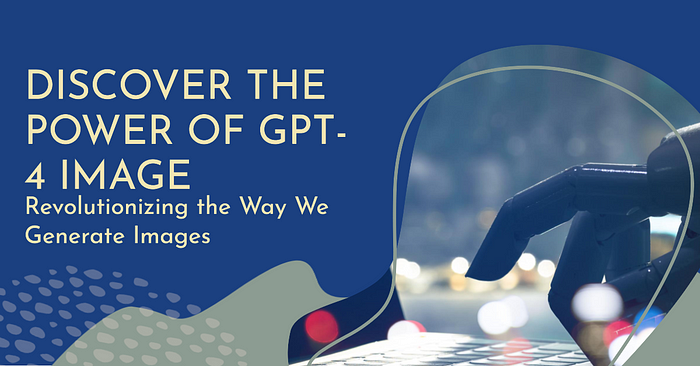How GPT-4 Image Works?
https://sanmancreations.com/how-gpt-4-image-works/

Introduction
In the fast-evolving realm of artificial intelligence, GPT-4 Image has emerged as a groundbreaking innovation that promises to reshape the way we interact with and interpret images. Building upon the success of its predecessor, GPT-3, this new model marks a significant milestone in the fusion of language and visual data. In this extensive blog post, we will delve deep into the intricacies of GPT-4 Image, exploring how it functions, its applications, and its potential impact on various industries.
Understanding the Foundation: Transformers
Before we plunge into the intricacies of GPT-4 Image, it’s essential to comprehend the foundation on which it stands — Transformers. The Transformer architecture, originally introduced by Vaswani et al. in their 2017 paper, has been pivotal in revolutionizing natural language processing (NLP) tasks. GPT-3, its predecessor, was built on this architecture and achieved remarkable success in various language-related tasks.
Transformers are designed to process sequential data, such as text, by considering the relationships between different elements within the sequence. They excel in tasks like language translation, sentiment analysis, and text generation. Now, GPT-4 takes this architecture and extends it to images.
GPT-4 Image: A Fusion of Language and Vision
GPT-4 Image takes the Transformer architecture a step further by combining it with visual data. Instead of processing text, this model can work with images and text simultaneously, making it a pioneering advancement in AI.
1. The Multimodal Approach
At the core of GPT-4 Image’s functionality is a multimodal approach. Unlike its predecessors, this model can understand and generate text while also interpreting images. It achieves this through a dual-stream architecture that can process both modalities independently. Here’s how it works:
a. Vision Stream
The vision stream of GPT-4 Image is responsible for processing image data. It uses a convolutional neural network (CNN) to extract visual features from the image. This network can identify objects, shapes, colors, and various other visual elements within the image.
b. Language Stream
The language stream is essentially a Transformer architecture, similar to what we’ve seen in GPT-3, which processes text data. This stream can generate text descriptions, answer questions, and perform a wide range of natural language processing tasks.
2. Cross-Modal Integration
The true power of GPT-4 Image emerges from its ability to connect the vision and language streams. It can perform cross-modal tasks, bridging the gap between images and text. This integration enables the model to describe images in natural language, answer questions about images, and even generate text based on the content of an image.
How Training Works
Training GPT-4 Image is a complex process that involves massive datasets and a significant amount of computational power. The model is pretrained on a diverse dataset consisting of images and their corresponding textual descriptions. This pretrained model learns to understand the relationships between images and text through a process called self-supervised learning.
During the pretraining phase, GPT-4 Image learns to predict missing parts of text and generate plausible textual descriptions for images it hasn’t seen before. This process helps the model develop a strong understanding of both modalities.
Once pretraining is complete, the model is fine-tuned on specific tasks. For example, it can be fine-tuned for image captioning, object detection, or even more complex tasks like visual question answering (VQA). Fine-tuning ensures that the model can adapt to specific applications and deliver better performance.
Applications of GPT-4 Image
GPT-4 Image has opened up a world of possibilities in various fields. Let’s explore some of the most prominent applications of this innovative AI model:
1. Image Captioning
One of the most straightforward applications of GPT-4 Image is generating textual descriptions for images. This is incredibly useful for accessibility purposes, as it can provide the visually impaired with detailed descriptions of the content within images. Additionally, it has practical applications in content generation for marketing and social media.
2. Visual Question Answering (VQA)
GPT-4 Image can answer questions about images. For example, if presented with a photograph, it can respond to questions like “What color is the car?” or “How many people are in the image?” This has enormous potential in various industries, including healthcare, where it can aid in medical image interpretation.
3. Content Creation
Content creators can leverage GPT-4 Image to generate text based on images, streamlining the process of content production. Whether it’s drafting product descriptions or writing articles, the model can provide valuable insights and textual content related to visual data.
4. Visual Storytelling
GPT-4 Image’s ability to connect images and text enables it to create compelling visual stories. This is a remarkable tool for multimedia content producers, enabling the creation of interactive and engaging narratives that incorporate both visual and textual elements.
5. Healthcare
In the healthcare industry, GPT-4 Image can assist medical professionals in analyzing medical images, interpreting X-rays and MRIs, and generating detailed reports. This can lead to faster diagnoses and improved patient care.
6. E-Commerce
E-commerce platforms can benefit from GPT-4 Image by providing more detailed product information, including image-based searches. Shoppers can simply upload an image of an item they want, and the model can find similar products from the catalog.
7. Autonomous Vehicles
For autonomous vehicles, GPT-4 Image can help improve object detection and classification. It enhances the vehicle’s ability to understand its surroundings, ensuring safer navigation.
Potential Challenges and Ethical Considerations
While GPT-4 Image is an impressive technology, it comes with a set of challenges and ethical considerations. Some of the key issues include:
1. Bias and Fairness
Like its predecessors, GPT-4 Image is susceptible to bias in its responses. It can inadvertently generate or reinforce stereotypes present in the training data. Addressing bias and ensuring fairness in AI models is an ongoing challenge.
2. Privacy Concerns
The model’s ability to generate textual descriptions from images raises concerns about privacy. It can potentially extract sensitive information from images, which may be misused. Protecting privacy is crucial in deploying this technology.
3. Data Requirements
Training and fine-tuning GPT-4 Image require massive datasets. Gathering and annotating such datasets can be time-consuming and costly, limiting access to this technology for smaller organizations.
4. Environmental Impact
The computational requirements for training AI models like GPT-4 Image have a substantial environmental footprint. Energy consumption and carbon emissions associated with training need to be considered.
The Future of GPT-4 Image
As GPT-4 Image continues to evolve and become more accessible, it holds the potential to revolutionize industries across the board. It can facilitate more natural and interactive human-computer interfaces, aid in creative content production, improve accessibility, and advance medical diagnoses, among other applications.
In the coming years, it is likely that we will see more fine-tuned versions of GPT-4 Image, specialized for specific tasks and industries. The model will become a staple in various sectors, contributing to improved efficiency and innovation.
Conclusion
GPT-4 Image represents a remarkable leap forward in AI technology,
FAQ: GPT-4 Image — How It Works and Its Applications
1. What is GPT-4 Image, and how does it differ from its predecessors?
GPT-4 Image is an advanced AI model that combines text and image processing. It can analyze images and generate textual content simultaneously, making it a significant leap in the GPT series. This multimodal approach sets it apart from its predecessors.
2. What is the role of Transformers in GPT-4 Image’s architecture?
Transformers are at the core of GPT-4 Image’s architecture. They are designed to process sequential data and establish relationships between elements within a sequence, which is essential for handling text and image data.
3. How does GPT-4 Image’s multimodal approach work?
GPT-4 Image employs a dual-stream architecture, including a Vision Stream for processing images and a Language Stream for handling text. The model can independently process these modalities and integrate them for various tasks.
4. What are the practical applications of GPT-4 Image for web designers?
Web designers can leverage GPT-4 Image for image captioning, content generation, visual storytelling, design inspiration, user interaction design, and more. It enhances creativity and streamlines the design process.
5. How is GPT-4 Image trained and fine-tuned?
GPT-4 Image is trained on massive datasets that include images and their corresponding textual descriptions. It undergoes self-supervised learning to understand the relationships between images and text. Fine-tuning on specific tasks further refines its performance.
6. What are the potential challenges and ethical considerations associated with GPT-4 Image?
Challenges include issues of bias and fairness, privacy concerns related to textual descriptions of images, data requirements for training, and environmental impact due to computational requirements.
7. In which industries can GPT-4 Image have a significant impact?
GPT-4 Image has applications in various fields, including healthcare (medical image analysis), e-commerce (product information and image-based searches), autonomous vehicles (object detection), content creation, and more.
8. What does the future hold for GPT-4 Image?
As GPT-4 Image continues to evolve, it is expected to become more accessible and integrated into numerous sectors. We may see specialized versions of the model for specific tasks, leading to improved efficiency and innovation.
9. How can web designers and businesses integrate GPT-4 Image into their workflow?
To integrate GPT-4 Image, web designers and businesses should consult with AI specialists or developers, ensure ethical use, prioritize data privacy, and review and edit AI-generated content to maintain quality standards.
10. How can GPT-4 Image contribute to user interaction design?
GPT-4 Image can assist in designing chatbots and virtual assistants, offering conversation scripts and dialogue flows, enhancing the user experience on websites.
11. How can GPT-4 Image enhance content creation for marketing and social media?
GPT-4 Image can generate text based on images, making it valuable for creating engaging and SEO-friendly content. This is particularly useful for writing product descriptions, blog posts, and social media content.
12. Can GPT-4 Image assist in image optimization for websites?
Yes, GPT-4 Image can suggest image optimization techniques, including resizing, compression, and alt text recommendations, to ensure images are web-ready and search engine-friendly.
13. How can GPT-4 Image contribute to image-based search in e-commerce?
E-commerce platforms can benefit from GPT-4 Image by allowing users to upload images of products they want to find. The model can then find similar products in the catalog.
14. Is GPT-4 Image suitable for creative storytelling and content generation?
Yes, GPT-4 Image’s ability to connect images and text allows it to create compelling visual stories, making it an excellent tool for multimedia content producers.
15. How can GPT-4 Image be used for rapid prototyping in web design?
Web designers can quickly prototype their ideas by providing rough sketches or descriptions to GPT-4 Image, which can generate visual representations or recommend design elements.
16. Can GPT-4 Image improve search engine optimization (SEO) for websites?
Yes, GPT-4 Image can suggest meta titles, meta descriptions, and keywords based on the visual content of the site, contributing to improved SEO.
17. What are the environmental considerations related to GPT-4 Image’s computational requirements?
The computational requirements for training AI models like GPT-4 Image can have a substantial environmental footprint, including energy consumption and carbon emissions, which should be taken into account.
18. How can GPT-4 Image contribute to user engagement through visual storytelling?
GPT-4 Image can create textual narratives based on images, enhancing user engagement on websites through interactive and engaging visual stories.
19. Can GPT-4 Image be used to generate design ideas for web projects?
Yes, web designers can use GPT-4 Image to find design inspiration by providing it with images or descriptions, and it can suggest design elements and concepts.
20. What are the key benefits of using GPT-4 Image in web design?
GPT-4 Image enhances creativity, efficiency, and accessibility in web design by providing AI-generated text for images, aiding in content creation, image optimization, user interaction design, and design inspiration.
